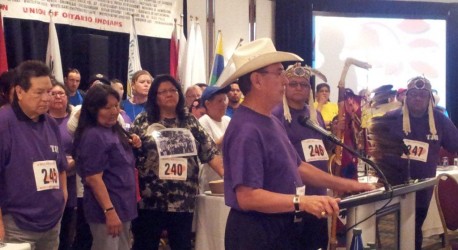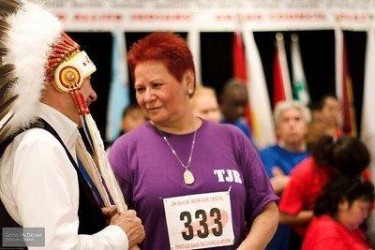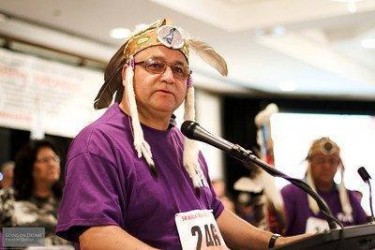Article Origin
Volume
Issue
Year
Six years ago on June 11, 2008, Prime Minister Stephen Harper offered an apology on behalf of Canada to Aboriginal people for the treatment they suffered at residential schools, calling it “a sad chapter in our history.”
Toronto’s Aboriginal community marked the anniversary of the apology with a five km walk and run billed as the Walk/Run for Truth, Justice and Reconciliation. Council Fire Native Cultural Centre organized the walk that started at their centre at Dundas and Parliament, wound through the city’s downtown and ended at the Eaton Chelsea Hotel where the 40th Annual All Ontario Chiefs Assembly was being held.
The chiefs welcomed the 250 walkers and runners from the Aboriginal community and ally groups into the final afternoon of their deliberations with a standing ovation. Council Fire organizer Andrea Chrisjohn described the objective of the Truth, Justice and Reconciliation Walk as broad to cover all the issues facing Indigenous people, “…whether it’s the missing or murdered women, the continuation of the dollars for Residential School survivors and the TRC to ensure we have our Indigenous place on our Indigenous lands on Turtle Island.”
The Truth and Reconciliation Commission (TRC) was represented by Chief Wilton Littlechild, TRC Commissioner, wearing his trademark cowboy hat. The poster for the walk featured Tom Longboat (1887-1949), an Onondaga runner from Six Nations who Littlechild described as “the world’s best runner in his time”.
Longboat was a residential school survivor, having attended Brantford’s Mohawk Institute. The City of Toronto had to reconcile with Longboat, said Littlechild. They awarded him a scholarship and wristwatch, which they never gave him, “because there was a protest by the US Olympic team that he was a professional because he was accepting money.” The scholarship and watch were finally given to Longboat’s family many years after he passed away.
An intergenerational survivor from Fort William First Nation spoke about his father who attended St. Anne’s Residential School in Fort Albany, Ont.
“He was a rotten person when he came out of that place,” he said. “He treated our family in a rotten way. We became victims because of him.” He broke down as he told about asking for forgiveness in his father’s last hours for, “being such a rotten son for 25 years.” He told the audience the only thing his father said to him was, ‘I love you, my son.’
He urged people not to forget the residential school survivors who are living on the streets and struggling with addictions. “What are we gonna do for those people out there?” he asked. “Think about those people that this process has left behind.”
Littlechild agreed that, “…we still have a long ways to go nationally in terms of putting action to the words of the apology.”
Ontario Regional Chief Stan Beardy commended the walkers for their commitment to change. “What happened to us as First Nations people in Canada is not an Indian problem,” he said. “We experience a lot of injustice, the Sixties Scoop, the residential schools and many other things including missing and murdered women…Those are Canada’s problems. What happened in the past is part of Canada’s history.”
Beardy urged people to tell their stories, and said, “We have to be able to tell the good parts and the bad parts.” It increases the general public’s understanding of First Nations issues and it also gives encouragement to the people coming behind us, he said, “…to know that what happens to us is not our fault.” Telling our stories will prevent it from happening again, he said.
Patrick Madahbee, Grand Council Chief of the Anishinabek Nation, also accompanied the walkers. “It’s so important the identity we have as Indigenous people,” he said. “We always talk about the past and we have to never forget what went on, the many injustices. But I think a new day is here. What’s going to be history for the next generations is what we’re starting from the work we do today.”
- 3229 views



